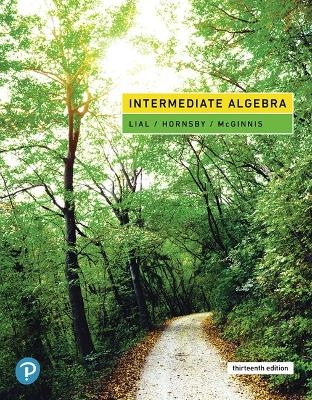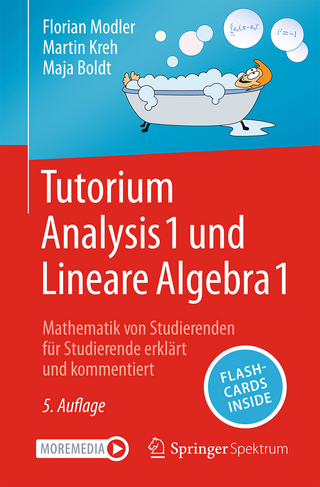
Intermediate Algebra
Pearson (Verlag)
978-0-13-489598-7 (ISBN)
Balancing skills and concepts The Lial Developmental Algebra Series uses a teacherly writing style and a careful blend of skills development and conceptual questions to meet the unique needs of the developmental math student. The author team takes advantage of experiences in the classroom and an editing eye to offer one of the most well-rounded series available, written with the developmental learner in mind. In this revision, the team retains their hallmark writing style, and provides new features and resources to optimize student preparedness and conceptual understanding. The Lial program provides students with the perfect balance of skills and concepts for a student-friendly approach to math.Also available with MyLab Math MyLabTM Math is the teaching and learning platform that empowers you to reach every student. By combining trusted author content with digital tools and a flexible platform, MyLab Math personalizes the learning experience and improves results for each student. Note: You are purchasing a standalone product; MyLab Math does not come packaged with this content. Students, if interested in purchasing this title with MyLab Math, ask your instructor to confirm the correct package ISBN and Course ID. Instructors, contact your Pearson representative for more information. If you would like to purchase both the physical text and MyLab Math, search for: 0135307686 / 9780135307687 Intermediate Algebra Plus MyLab Math with Pearson eText - Access Card Package Package consists of:
0134895983 / 9780134895987 Intermediate Algebra
013489684X / 9780134896847 MyLab Math with Pearson eText - Standalone Access Card - for Intermediate Algebra
About our authors The late Marge Lial was always interested in math; it was her favorite subject in the first grade! Marge's intense desire to educate both her students and herself has inspired the writing of numerous best-selling textbooks. Marge, who received Bachelor's and Master's degrees from California State University at Sacramento, was affiliated with American River College. An avid reader and traveler, her travel experiences often found their way into her books as applications, exercise sets, and feature sets. Her interest in archeology led to trips to various digs and ruin sites, producing some fascinating problems for her textbooks involving such topics as the building of Mayan pyramids and the acoustics of ancient ball courts in the Yucatan. When John Hornsby enrolled as an undergraduate at Louisiana State University, he was uncertain whether he wanted to study mathematics education or journalism. His ultimate decision was to become a teacher, but after 25 years of teaching at the high school and university levels and 15 years of writing mathematics textbooks, both of his goals have been realized. His love for both teaching and for mathematics is evident in his passion for working with students and fellow teachers as well. His specific professional interests are recreational mathematics, mathematics history, and incorporating graphing calculators into the curriculum. John's personal life is busy as he devotes time to his family (wife Gwen, and sons Chris, Jack, and Josh), and has been an avid baseball fan all of his life. John's other hobbies include numismatics (the study of coins) and record collecting. He loves the music of the 1960s and has an extensive collection of the recorded works of Frankie Valli and the Four Seasons. A native Midwesterner, Terry McGinnis received her Bachelor’s of Science in Elementary Education with a concentration in Mathematics from Iowa State University. She has taught elementary and middle school mathematics and developed and implemented the curriculum used with her students. Terry has been involved in college mathematics publishing for over 20 years, working with a variety of authors on textbooks in both developmental mathematics and precalculus. After working behind the scenes on many of the Lial/Hornsby textbooks and supplements for over 10 years, Terry joined Margaret Lial and John Hornsby in 2002 as coauthor of their developmental mathematics series. When not working, Terry enjoys spinning at a local health club, walking, and reading fiction. She is the devoted mother of 2 sons, Andrew and Tyler.
Study Skills
Study Skill 1: Using Your Math Text
Study Skill 2: Reading Your Math Text
Study Skill 3: Taking Lecture Notes
Study Skill 4: Completing Your Homework
Study Skill 5: Using Study Cards
Study Skill 6: Managing Your Time
Study Skill 7: Reviewing a Chapter
Study Skill 8: Taking Math Tests
Study Skill 9: Analyzing Your Test Results
Study Skill 10: Preparing for Your Math Final
Review of the Real Number System
R.1 Fractions, Decimals, and Percents
R.2 Basic Concepts from Algebra
R.3 Operations on Real Numbers
R.3 Exponents, Roots, and Order of Operations
R.4 Properties of Real Numbers
Chapter R Summary
Chapter R Test
Linear Equations, Inequalities, and Applications
1.1 Linear Equations in One Variable
1.2 Formulas and Percent
1.3 Applications of Linear Equations
1.4 Further Applications of Linear Equations
Summary Exercises: Applying Problem-Solving Techniques
1.5 Linear Inequalities in One Variable
1.6 Set Operations and Compound Inequalities
1.7 Absolute Value Equations and Inequalities
Summary Exercises: Solving Linear and Absolute Value Equations and Inequalities
Chapter 1 Summary
Chapter 1 Review Exercises
Chapter 1 Mixed Review Exercises
Chapter 1 Test
Chapters R and 1 Cumulative Review Exercises
Linear Equations, Graphs, and Functions
2.1 Linear Equations in Two Variables
Study Skills: Managing Your Time
2.2 The Slope of a Line
2.3 Writing Equations of Lines
Summary Exercises: Finding Slopes and Equations of Lines
2.4 Linear Inequalities in Two Variables
2.5 Introduction to Relations and Functions
2.6 Function Notation and Linear Functions
Chapter 2 Summary
Chapter 2 Review Exercises
Chapter 2 Mixed Review Exercises
Chapter 2 Test
Chapters R–2 Cumulative Review Exercises
Systems of Linear Equations
3.1 Systems of Linear Equations in Two Variables
3.2 Systems of Linear Equations in Three Variables
3.3 Applications of Systems of Linear Equations
Chapter 3 Summary
Chapter 3 Review Exercises
Chapter 3 Mixed Review Exercises
Chapter 3 Test
Chapters R–3 Cumulative Review Exercises
Exponents, Polynomials, and Polynomial Functions
4.1 Integer Exponents
4.2 Scientific Notation
4.3 Adding and Subtracting Polynomials
4.4 Polynomial Functions, Graphs, and Composition
4.5 Multiplying Polynomials
4.6 Dividing Polynomials
Chapter 4 Summary
Chapter 4 Review Exercises
Chapter 4 Mixed Review Exercises
Chapter 4 Test
Chapters R–4 Cumulative Review Exercises
Factoring
5.1 Greatest Common Factors and Factoring by Grouping
5.2 Factoring Trinomials
5.3 Special Factoring
5.4 A General Approach to Factoring
5.5 Solving Equations by the Zero-Factor Property
Chapter 5 Summary
Chapter 5 Review Exercises
Chapter 5 Mixed Review Exercises
Chapter 5 Test
Chapters R–5 Cumulative Review Exercises
Rational Expressions and Functions
6.1 Rational Expressions and Functions; Multiplying and Dividing
6.2 Adding and Subtracting Rational Expressions
6.3 Complex Fractions
6.4 Equations with Rational Expressions and Graphs
Summary Exercises: Simplifying Rational Expressions vs. Solving Rational Equations
6.5 Applications of Rational Expressions
6.6 Variation
Chapter 6 Summary
Chapter 6 Review Exercises
Chapter 6 Mixed Review Exercises
Chapter 6 Test
Chapters R–6 Cumulative Review Exercises
Roots, Radicals, and Root Functions
7.1 Radical Expressions and Graphs
7.2 Rational Exponents
7.3 Simplifying Radicals, the Distance Formula, and Circles
7.4 Adding and Subtracting Radical Expressions
7.5 Multiplying and Dividing Radical Expressions
Summary Exercises: Performing Operations with Radicals and Rational Exponents
7.6 Solving Equations with Radicals
7.7 Complex Numbers
Chapter 7 Summary
Chapter 7 Review Exercises
Chapter 7 Mixed Review Exercises
Chapter 7 Test
Chapters R–7 Cumulative Review Exercises
Quadratic Equations, Inequalities, and Functions
8.1 The Square Root Property and Completing the Square
8.2 The Quadratic Formula
8.3 Equations That Lead to Quadratic Methods
Summary Exercises: Applying Methods for Solving Quadratic Equations
8.4 Formulas and Further Applications
8.5 Graphs of Quadratic Functions
8.6 More about Parabolas and Their Applications
8.7 Polynomial and Rational Inequalities
Chapter 8 Summary
Chapter 8 Review Exercises
Chapter 8 Mixed Review Exercises
Chapter 8 Test
Chapters R–8 Cumulative Review Exercises
Inverse, Exponential, and Logarithmic Functions
9.1 Inverse Functions
9.2 Exponential Functions
9.3 Logarithmic Functions
9.4 Properties of Logarithms
9.5 Common and Natural Logarithms
9.6 Exponential and Logarithmic Equations; Further Applications
Chapter 9 Summary
Chapter 9 Review Exercises
Chapter 9 Mixed Review Exercises
Chapter 9 Test
Chapters R–9 Cumulative Review Exercises
Nonlinear Functions, Conic Sections, and Nonlinear Systems
10.1 Additional Graphs of Functions
10.2 Circles Revisited and Ellipses
10.3 Hyperbolas and Functions Defined by Radicals
10.4 Nonlinear Systems of Equations
10.5 Second-Degree Inequalities and Systems of Inequalities
Chapter 10 Summary
Chapter 10 Review Exercises
Chapter 10 Mixed Review Exercises
Chapter 10 Test
Chapters R-10 Cumulative Review Exercises
Further Topics in Algebra
11.1 Sequences and Series
11.2 Arithmetic Sequences
11.3 Geometric Sequences
11.4 The Binomial Theorem
Chapter 11 Summary
Chapter 11 Review Exercises
Chapter 11 Mixed Review Exercises
Chapter 11 Test
Chapters R-11 Cumulative Review Exercises
Appendix A: Synthetic Division
Answers to Selected Exercises
Credits
Index
| Erscheinungsdatum | 28.01.2019 |
|---|---|
| Sprache | englisch |
| Maße | 222 x 282 mm |
| Gewicht | 2000 g |
| Themenwelt | Mathematik / Informatik ► Mathematik ► Algebra |
| ISBN-10 | 0-13-489598-3 / 0134895983 |
| ISBN-13 | 978-0-13-489598-7 / 9780134895987 |
| Zustand | Neuware |
| Informationen gemäß Produktsicherheitsverordnung (GPSR) | |
| Haben Sie eine Frage zum Produkt? |
aus dem Bereich


